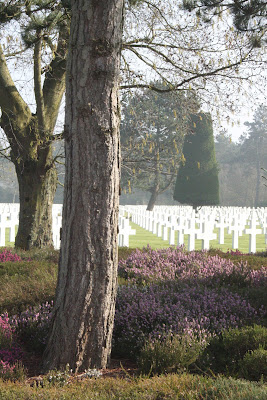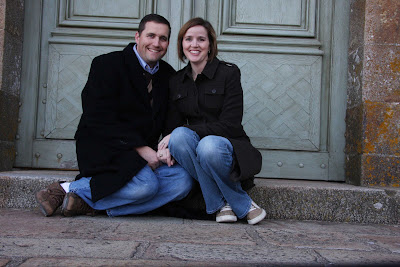Day Two! Mont St. Michel & Normandy
Today, we opened our eyes to this beaut…Mont St. Michel. This Benedictine Abbey (a prison at one time) sits on the northern coast of France on the English Channel. We were there during low tide, where the waves go out a full 9 miles before coming back in during high tide. It was a little chilly, but that made for some gorgeous blue skies. Our walk took us up, and up and up. I’m telling you, the stairmaster ain’t got nothing on the Mont. I seriously thought I might need an oxygen tank.

Believe it or not, this thing has been around (although it started out significantly smaller and was added to over the years) in the 6th century. Hello? That’s old. This is a little background on its beginnings:
“Before the construction of the first monastic establishment in the 8th century, the island was called Mont Tombe. According to legend, the archangel Michael appeared to St. Aubert, bishop of Avranches, in 708 and instructed him to build a church on the rocky islet. But Aubert repeatedly ignored the angel’s instruction until Michael burned a hole in the bishop’s skull with his finger. That did the trick. The dedication to St Michael occurred on October 16, 708.”

 Low tide – can you believe how far we could see?
Low tide – can you believe how far we could see?
 I’ll admit, going to northern France was all Scott’s doing. He saw a photo of this place in one of our travel books and insisted we go. I was a wee bit skeptical only because it took about a 4-hour car ride with lovely Jane. Totally worth it. Scott was right – did you get that honey? We packed our bags, hauled them back down the mountain to our little Polka Dot and headed off to Pointe du Hoc and Omaha Beach to relive “the longest day.” On our way, we had to pull over and snap this photo. Hey, what can I say? We’re Aggies, like real Aggies with our agriculture degrees. We loved comparing the countryside, the wheat fields, the dairy farms and the cattle breeds to the states. On our drives around France, we were struck by how much of the country is just that – France has its big cities, but it’s largely an agricultural country with some breathtaking views.
I’ll admit, going to northern France was all Scott’s doing. He saw a photo of this place in one of our travel books and insisted we go. I was a wee bit skeptical only because it took about a 4-hour car ride with lovely Jane. Totally worth it. Scott was right – did you get that honey? We packed our bags, hauled them back down the mountain to our little Polka Dot and headed off to Pointe du Hoc and Omaha Beach to relive “the longest day.” On our way, we had to pull over and snap this photo. Hey, what can I say? We’re Aggies, like real Aggies with our agriculture degrees. We loved comparing the countryside, the wheat fields, the dairy farms and the cattle breeds to the states. On our drives around France, we were struck by how much of the country is just that – France has its big cities, but it’s largely an agricultural country with some breathtaking views. After we got our agriculture fix, we arrived at the Normandy beaches, specifically Pointe du Hoc. This place had some special meaning to Scott and I. A certain Colonel, James Earl Rudder (a mighty fine figure at Texas A&M), and his troops played a key role on D-Day. Here’s some history…
After we got our agriculture fix, we arrived at the Normandy beaches, specifically Pointe du Hoc. This place had some special meaning to Scott and I. A certain Colonel, James Earl Rudder (a mighty fine figure at Texas A&M), and his troops played a key role on D-Day. Here’s some history…
 After an emotional moment at Pointe du Hoc, we headed to the U.S. Memorial. The gift of land was given to the U.S. by the French. It was an emotional and surreal day as we strolled through the cemetery and shed some tears. People keep saying, “I bet going to Normandy was amazing.” It was, but it was so much more than that. History became reality, stories became life and places became memorials. It was a day to remember and it was a day to be thankful.
After an emotional moment at Pointe du Hoc, we headed to the U.S. Memorial. The gift of land was given to the U.S. by the French. It was an emotional and surreal day as we strolled through the cemetery and shed some tears. People keep saying, “I bet going to Normandy was amazing.” It was, but it was so much more than that. History became reality, stories became life and places became memorials. It was a day to remember and it was a day to be thankful.  A pictorial view of the pre-emptive air strikes by forces prior to D-Day.
A pictorial view of the pre-emptive air strikes by forces prior to D-Day.









It is so funny the similarities to some of our trips. In Italy we rented a manual Puntos with Jane as our navigator. When we were in Paris we witnessed a pick pocket steal a guys wallet. It was over and the thief slipped down into the metro before we even knew what happened. I meant to warn you about that. Sounds like Northern France was pretty amazing. I guess I need to add that to my wish list of travel destinations.
Those Europeans really know their stuff when it comes to churches don’t they!? Wow! They truly know how to express the glory of God in a very human and tangible way – simply amazing.
[…] If you’d like to read more about our day in Normandy, click HERE. […]